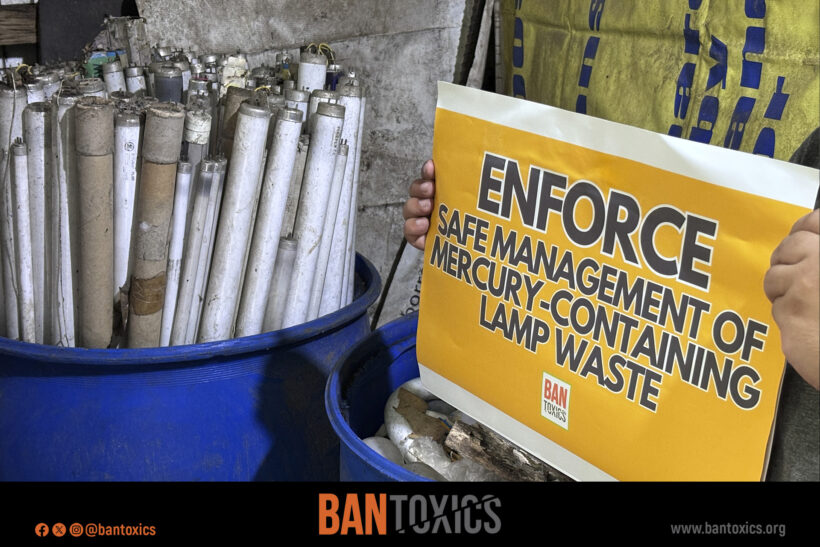Toxic and Waste Watchdog Inspects Busted Lamp Stockpile in QC Barangay, Detects Mercury Leakage
Toxic watchdog group BAN Toxics recently detected mercury leakage from a stockpile of busted
fluorescent lamps stored in a barangay in Quezon City. Following a series of consultations by the group with barangays around the Quirino Memorial Medical Center (QMMC) for the Philippine Healthcare and mercury Wastes Management Project (PHCWMP), officials from Barangay Blue Ridge A informed BAN Toxics about their stockpile.
According to Barangay Captain Gabriel Legaspi, the stockpile was collected from their community as part of the Quezon City Local Government Unit’s (LGU) previous efforts to ensure the proper disposal of hazardous waste from households. However, Legaspi noted that the last collection of Quezon City LGU of such waste was probably around 2018, and since then, they have already accumulated six drumloads, each containing about 50 busted fluorescent lamps.
On September 6, 2024, a team from BAN Toxics, led by the group’s Campaign and Advocacy Officer, Thony Dizon, inspected the stockpile. Using a portable Olympus Vanta C Series X-Ray Fluorescence (XRF) analyzer, the group detected mercury leakage of up to 130 parts per million (ppm) from some of the lamps. The stockpile was stored in a covered shed inside the barangay LGU compound, which used to serve as their material recovery facility (MRF).

According to Jam Lorenzo, BAN Toxics Deputy Executive Director, a 130 ppm leakage from busted fluorescent lamps is relatively high, and there is a strong probability that the ambient air inside the shed is already contaminated. He pointed out that mercury from fluorescent lamps shouldn’t be detectable by an XRF analyzer unless there is leakage.
BAN Toxics has advised the barangay to temporarily cover and seal the stockpile to prevent further contamination and to limit access to the shed. If entry is necessary, they should ensure that personal protective equipment is worn. Meanwhile, Barangay Captain Legaspi said they will follow up with the Quezon City LGU to assist in the proper transport and disposal of the stockpile.
Under Republic Act 6969, the “Toxic Substances and Hazardous and Nuclear Wastes Control Act of 1990,” busted fluorescent lamps are classified as hazardous waste due to their mercury content. Other related laws and regulatory policies also govern the management of fluorescent lamp waste, including Republic Act 9003, the “Ecological Solid Waste Management Act of 2000,” Republic Act 7394, the “Consumer Act of the Philippines,” and the Joint Administrative Order (JAO) 2013-09-2001 by the Department of Environment and Natural Resources (DENR) and the Department of Energy (DoE).
At the level of the LGU, Section 5 of Quezon City Ordinance 2350-2014 states that busted fluorescent lamps and spent batteries from “households, government and public institutions shall be separated from domestic wastes” and “shall be brought to the Barangay MRF for temporary storage until collection by the city-contracted hazardous waste collector/transporter/treater.”

“We call on Brgy. Blue Ridge A and the Quezon City LGU’s Department of Sanitation and Cleanup Works (DSQC) to immediately coordinate and address the stockpile to prevent further mercury contamination. We also urge DSQC to conduct a survey in other barangays of Quezon City to determine if there are existing stockpiles,” Dizon said.
Dizon likewise called on the Department of Energy to revisit JAO 2013-09-2001, also known as the Lighting Industry Waste Management Guidelines. This JAO mandates producers to develop a lamp waste management plan, which includes establishing a lamp waste management facility. However, to BAN Toxics’ knowledge, this has not been fully implemented.
Mercury is a highly toxic chemical that can cause irreparable damage to the nervous system. Inhaling mercury vapor can adversely affect the nervous, digestive, and immune systems, as well as the lungs and kidneys, and can potentially be fatal. It has long environmental persistence and global mobility—cycling through the atmosphere, ocean, and land. Its emissions and releases can bioaccumulate and biomagnify in the food chain, posing a significant threat to human health and the environment.
Under the Minamata Convention on Mercury, a global treaty to which the Philippines is a party, and the DENR Administrative Order 2019-20, “Revised Chemical Control Order for Mercury and Mercury Compounds,” certain types of fluorescent lamps should already have been phased out by 2022.

Currently, BAN Toxics is working with the DENR-Environmental Management Bureau on the PHCWMP, which has one of its main project components focused on the management, reduction, and disposal of mercury waste from healthcare facilities, including fluorescent lamp waste. In recent weeks, BAN Toxics has been conducting data collection activities in barangays surrounding hospitals involved in the project, such as QMMC, Eastern Visayas Medical Center in Tacloban City, and Cagayan Valley Medical Center in Tuguegarao City.
Officially launched on December 6, 2023, the PHCWMP is a five-year project, funded by the Global Environment Facility (GEF), and being implemented by the United Nations Industrial Development Organization (UNIDO), with the DENR-EMB as the national lead agency and BAN Toxics as the executing entity. PHCWMP aims to reduce the release and emissions of hazardous chemicals in healthcare wastes through environmentally sound practices.

Editor’s note: After BAN Toxics’ visit, Barangay Blue Ridge A coordinated with the Quezon City DSQC to request the collection of their stockpile of busted lamps. They have also secured the drums with protective covers and seals to prevent further contamination. The stockpile is now ready for pick-up.
References:
https://quezoncitycouncil.ph/ordinance/SP/SP-2350,%20S-2014.pdf
https://chemical.emb.gov.ph/wp-content/uploads/2019/11/DAO201920MERCURY.pdf
https://www.who.int/news-room/fact-sheets/detail/mercury-and-health






